#Gorillas in the Mist The Story of Dian Fossey
Photo
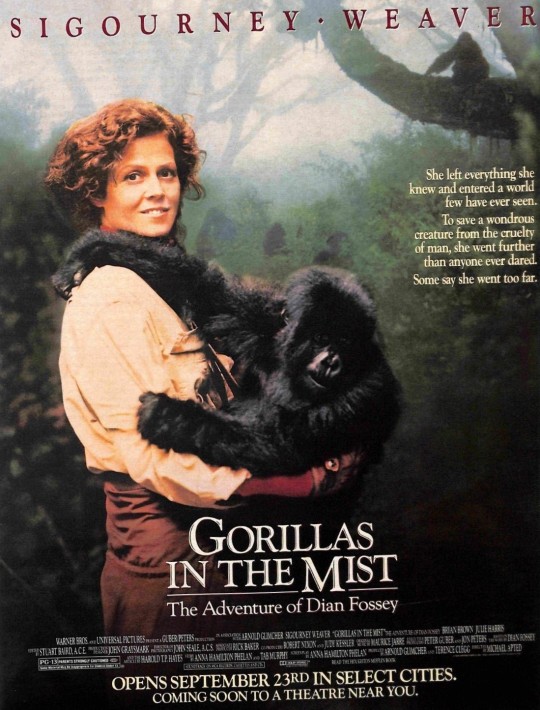
#Gorillas in the Mist The Story of Dian Fossey#Gorillas in the Mist#Dian Fossey#Sigourney Weaver#Michael Apted#Harold T.P. Hayes#Anna Hamilton Phelan#Tab Murphy#80s
31 notes
·
View notes
Text
Movie Recs In Honor of Kingdom of the Planet of the Apes
I decided to write out a list of movies to watch in honor of Kingdom of the Planet of the Apes coming out very soon. This list will feature movies with apes besides the POTA movies, or movies with weird and bizarre friendships/found families.
The Original Planet of the Apes Franchise (1968-1973, Amazon Prime)
Honestly, I've only watched the 1968 movie a handful of times. I decided to watch all of the original franchise leading up to the release of Kingdom. They're all a lot of fun, with social/political commentaries at the time of each film. If you're a movie collector, or like behind-the-scenes/director's commentaries, I highly recommend buying the Blu Ray compilation pack.
2. Tim Burton's Planet of the Apes (2001, Disney+ or Amazon Prime)
I know, hear me out. Yes, it's over-hated, and yes, there was A LOT of potential for this movie. There were definitely too many "cooks in the kitchen" when drafting this movie. Imho, I think it's a guilty pleasure, popcorn movie. If you're a fan of makeup effects, Rick Baker (THE modern makeup effects master) does an absolutely phenomenal job with the designs of the apes in this movie (and check out his Instagram too). I do like the production and the ape costume designs for this film as well.
Tim Roth and Paul Giamatti are such a blast in this movie, too!
And the posters for this movie look so cool.
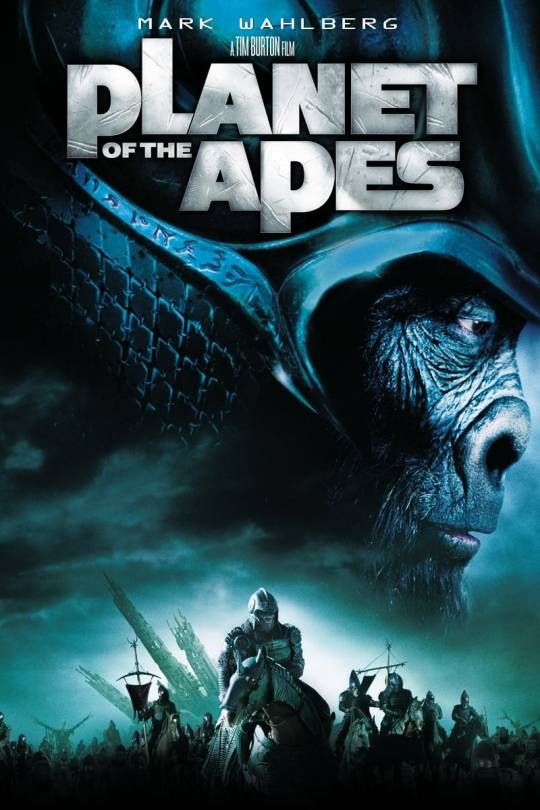

3. Planet of the Apes Reboot Trilogy (2011-2017, Amazon Prime)
I think this is what the 2001 movie should have been, and was trying to go for. While the three movies did make their money back at the box office, I have two theories why they almost went under everyone's radar (again, this is my opinion):
A. Because of the mixed reception from the 2001 movie.
B. Because of the abundance of comic book & remake movies coming out during the 2011-2017 years.
I put this trilogy right up with the Lord of the Rings and Star Wars. The storytelling is great, the special effects hold up well, and this reboot's version of Caesar has became one of my favorite main characters in modern film.
4. Mighty Joe Young (1998 remake, Disney+)
I don't know why this movie doesn't get talked about that much. Rick Baker, once again, does incredible work on the special effects for Joe. There's also a great musical score by James Horner. And Bill Paxton and Charlize Theron give amazing acting performances. And I think it's actually one of the better remakes that came out from the late 1990s.
In fact, the team that worked on the 1933 King Kong also made the 1949 film. Even Robert Armstrong (Carl Denham) came back for the '49 film. Ray Harryhausen worked under the supervision of Willis O'Brien for the special effects for the original movie. He also has a cameo appearance alongside Terry Moore (Jill Young) in a party scene.
Aaaaand I just found out the writers, Mark Rosenthal and Lawrence Konner, also did an uncredited rewrite for the 2001 POTA movie.
5. Tarzan (1999, Disney+)
Of course, who doesn't love Tarzan??? And Phil Collins's A.M.A.Z.I.N.G soundtrack???!!!
6. King Kong (1933, 2005, Amazon Prime/MAX)
Okay, technically it's a giant monster movie and the OG prior to Godzilla. And it also set the standard of film making overall. However, it is also a bit of a Beauty and the Beast story, hence the lines: "It was Beauty killed the Beast" and the "And the prophet said: And lo, the Beast looked upon the face of Beauty. And it stayed its hand from killing. And from that day forward, he was as one dead." I also recommend watching the extended cut of the 2005 remake.
7. Lilo & Stitch (2002, Disney+)
Again, who doesn't love Lilo and Stitch???
8. How to Train Your Dragon Trilogy (2010-2019, Amazon Prime/Peacock App)
Once again, who doesn’t love HTTYD (and why are they remaking it as a live action movie????)???
9. Gorillas in the Mist (1988, Amazon Prime)
This movie is about Dian Fossey (played by Sigourney Weaver), a primatologist who studied mountain gorillas and she was part of a trio of women who studied great apes; the amazing Jane Goodall and her study of chimpanzees, and Birute Galdikas who studies orangutans. The movie is also based on her book of the same name.
I use past tense for Dian, because she met a tragic and horrific death while she was conducting her research on gorillas. I have in-lined a link to Dian Fossey's Wikipedia article for further reading.
Rick Baker, once again, does some amazing practical creature effects work for the gorillas.
10. George of the Jungle (1997, Disney+)
One of my favorite Brendan Fraser movies, and such a fun, and a bit of a campy movie based on the cartoon series (which is also a spoof of Tarzan). I quote this movie every so often. Unfortunately, Rick Baker did not do the ape designs for this movie. The creature effects this time around was done by none other than the Jim Henson Creature Workshop!
#movies#sci fi#planet of the apes#movie recs#tarzan#mighty joe young#king kong#planet of the apes 2001#tim burton#the iron giant#how to train your dragon#lilo and stitch#gorillas in the mist#george of the jungle#movie recommendations#science fiction
5 notes
·
View notes
Text
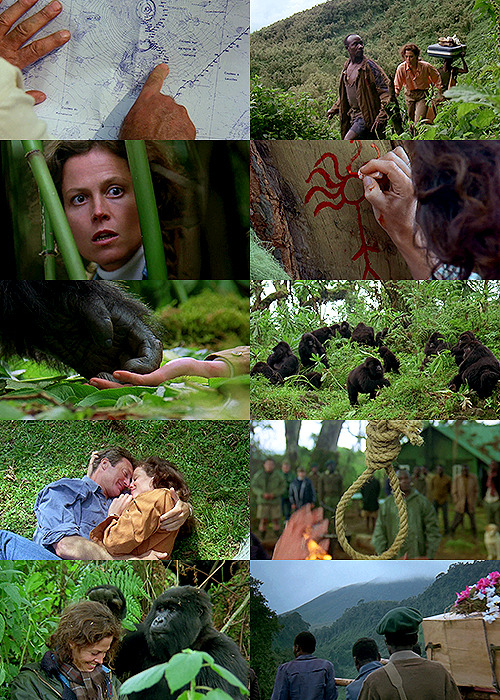
Gorillas in the Mist (1988). The story of Dian Fossey, a scientist who came to Africa to study the vanishing mountain gorillas, and later fought to protect them.
Messy, clunkily paced, and dated, Gorillas in the Mist still somehow managed the unthinkable in the 80s which was to depict a real woman as she was. It empathises with Fossey, and depicts her mission and connection to the gorillas deeply, but doesn't shy from her entitlement and terrorism either. It helps that she's played by Sigourney Weaver, who's always good but is in top form here, playing these shades of Fossey with real nuance. The result is an uneven film grounded by a great performance. 6/10.
#gorillas in the mist#1988#Oscars 61#Nom: Actress#Nom: Adapted Screenplay#Nom: Score#Nom: Sound#Nom: Editing#dian fossey#1960s#1970s#1980s#romance#gorillas#animals#rwanda#science#6/10#Michael Apted#Harold T.P. Hayes#anna hamilton phelan#sigourney weaver#bryan brown#julie harris
3 notes
·
View notes
Text
nature 'n me 💏 (unit 01)
Sanctuary. When I think of my relationship with nature, it’s this word that is enduringly intertwined with the concept. I treasure my relationship with nature because of the absolute sense of belonging that it grants me. It’s easy, I think, to feel insecure in the day-to-day, to constantly feel a need to prove yourself, to prove that you do belong. In this way, being with nature has always offered me an unmatched sense of clarity and calm. Nature Club™ is “no membership required” & “no prior experience needed”.
Of course I belong, because everyone does. In other aspects of life, I think that that sentiment, in an entirely genuine sense, is pretty hard to come by. It’s also so so easy to get caught up in the “me me me” rumination. Getting outside, being in the fresh air surrounded by green, that is where I feel like I can really truly think, and also where I feel like I don’t necessarily need to. The tunnel-vision of my own life opens up, and there is so much more to see and appreciate. Being in nature is being in a place larger than my own life, or than anyone’s - it’s being in the place where everything connects.
Nature feels like family, and it feels like home.
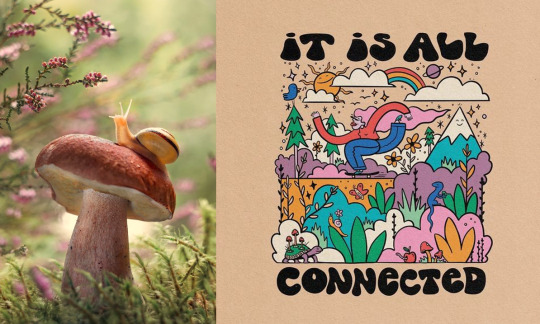
images sourced from Pinterest
(left) Photographer: ГОРЮКИНА ИРИНА (AIRIN GORUKINA)
(right) Artist: Hannah Eddy
The idea of nature being a sanctuary for me, for my thoughts, goes back to being a kid. In childhood, “going outside” was much less of a deliberate act, I think. Even then (though I maybe didn’t realize it), it was the one place where my mind could run wild and free - where it was entirely up to me to ‘preoccupy’ myself. Really, this just meant being alone with my thoughts, but not in a spooky existential way. Instead, I was free from the constraints of media (TV, internet, even books) and entertaining myself meant dreaming up imaginary and fanciful stories about the twigs, pebbles, and plants around me. I grew up right across from the St. Lawrence River in southeastern Ontario. For as long as I can remember, this was my happy place. It was my own personal taste of wilderness, a place I could feel the breeze coming off the water, where I could sift through the treeline and lose track of time. As a kid, my family didn’t really prioritize typical outdoorsy activities, so this was my own way to seek that out. This is where Mother Nature and I signed our BFF contract.
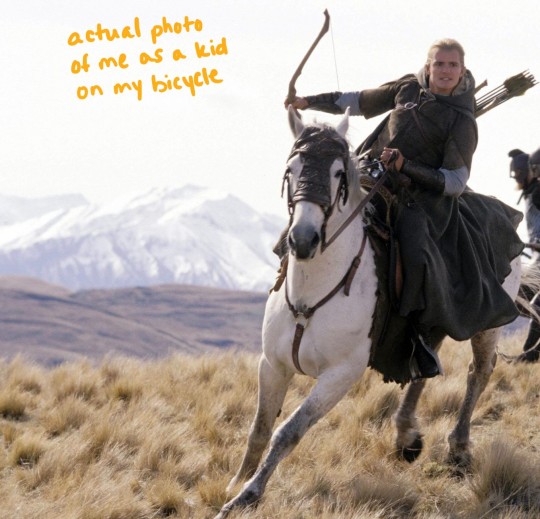
image (without text) sourced from https://www.brego.net/lord-of-the-rings/horses/horses-of-rohan/
So yeah, nature does give me perspectives that feel impossible to access through screens and pages. Still, I think these forms media are actually what really sparked our friendship. Little me did everything possible to convince herself that no, she’s not riding her bike on a path in the treeline, she’s actually Legolas on horseback, halfway through an epic journey in Middle Earth. Lord of the Rings and other fantasy movies and novels had all the elements of wondering about and appreciating nature. Even now, that childhood magic still trickles in here and there during hikes, ski trips, and time spent in the sun. Later on, more realistic depictions of nature had me hooked. I remember watching “Gorillas in the Mist”, a fictional telling of Diane Fossey’s story, in my grade 10 science class. The thought of being immersed in a rainforest for weeks on end was one I couldn’t (and wouldn’t) shake. Then came my discovery of Jane Goodall's work and David Attenborough-narrated nature documentaries. I’m now a fourth year zoology student, and in the spirit of full disclosure, I have to admit that all of those played a huge role in my choosing this major. As I said, my family wasn’t huge on raising a bunch of little naturalists, so I honestly think I have these forms of media to thank in giving me my sense of place and sparking a lifelong interest in the wonder of the natural world.
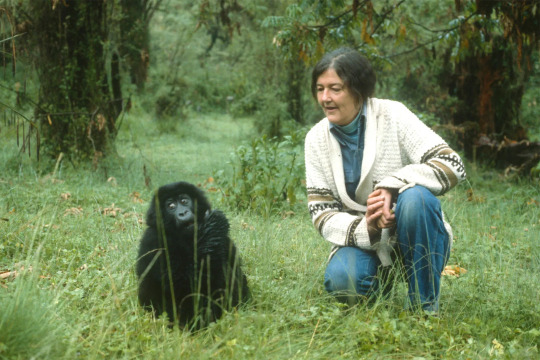
image sourced from https://www.britannica.com/biography/Dian-Fossey
These days, somewhat unfortunately, I think making time to get outside has to be more intentional. The responsibilities pile up, we get busy, and all of a sudden we’ve spent the better part of a week cooped up in classrooms, libraries, and apartment rooms. Nature and me are like long-distance best friends sometimes. Even though I haven’t visited home for too long, I know she’ll welcome me back, and the love will still be there 💚
1 note
·
View note
Text
#1 movie for September 26, 1988
Average Movie Ticket Price: $4.11
#80sMovies
Movie: Gorillas in the Mist: The Story of Dian Fossey
IMDb: https://www.imdb.com/title/tt0095243/?ref_=ext_shr_lnk
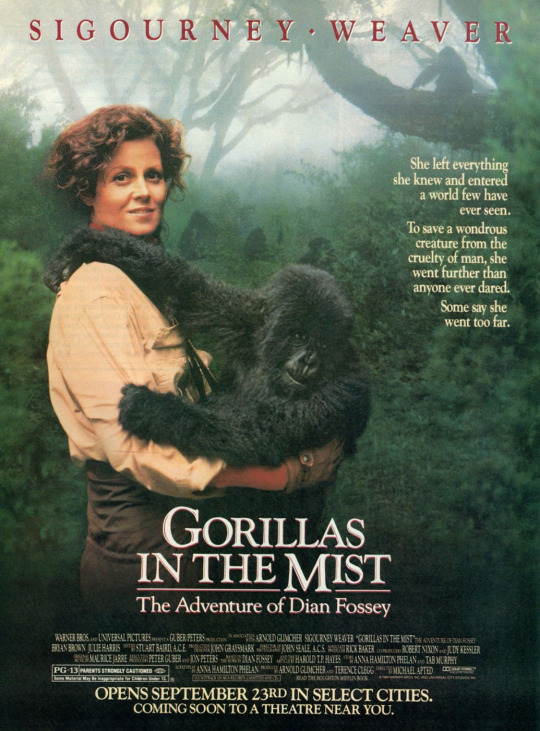
0 notes
Photo
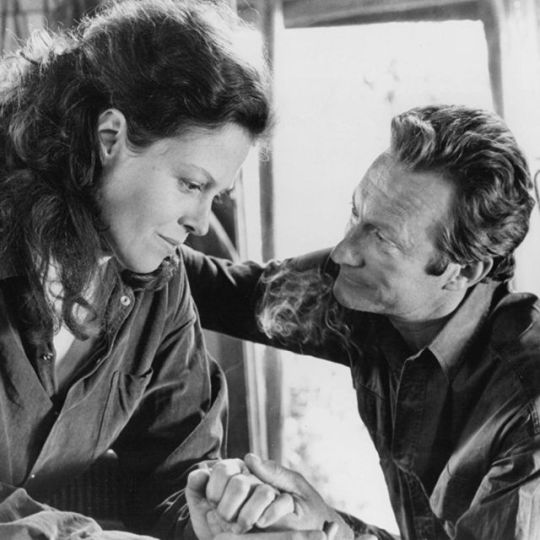
Bryan Brown y Sigourney Weaver en “Gorilas en la Niebla” (Gorillas in the Mist: The Story of Dian Fossey), 1988
#Gorilas en la niebla#Gorillas in the Mist: The Story of Dian Fossey#1988#1980s#pelícukas#Parejas#actores#actrices#bryan brown#Sigourney Weaver
9 notes
·
View notes
Photo
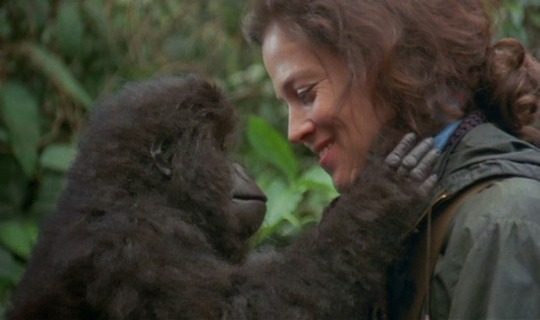
GORILLAS IN THE MIST (1988). Michael Apted directs Sigourney Weaver as animal scientist Diane Fossey studying wild gorillas in Rwanda.
#film#cinema#gorillas in the mist#sigourney weaver#gorilla#rwanda#africa#jungle#gorillas#gorilla costume#science#scientist#diane fossey#jane goodall#michael apted#1980s#drama#biopic#biography#true story
72 notes
·
View notes
Note
hello!! hope you're well! just saw ur response to the "properly formed society" comment on the carrier bag theory ursula post, i felt like the way u answered was so gentle but firm and informed. was wondering if u could maybe share some recommendations for texts to read more about this? cos i agree w/ the idea but its hard to find books like that. for example i think yuval's book ultimately has this kind of idea behind it (havent read it but from what ive read OF it, thats the vibe). thank u!!
sorry the word limit probably didn't help me express that right, i meant more books about anthro that focus on exploring human nature and our beginnings with a less "man is violent. man is the best supreme species. progress greatest invention. colonialism good because progress" yadda yadda yadda kind of deal, does this make sense? thank you again. also i think im obligated now to ask u your garbage ship of the week
I’m much more of an article person than a book person because I can only take so much dry jargon filled writing for so long, but I do have some suggestions.
The biggest one is probably Questioning Collapse. For context, Jared Diamond is a man (not an anthropologist) that shares all his theories on how past civilizations, such as the Greenland Norse, or the Rapa Nui, or the Maya, collapsed, in the terribly titled book Collapse: How Societies Choose to Fail or Succeed (yikes). Let's get some things straight though. Jared Diamond proved in his book Guns, Germs, and Steel, that he is a white supremacist who exploited the people of Papua New Guinea and believes that euro imperialism was just , bound to happen because europeans were more "civilized." So it was no surprise when all his favorite themes, that people, especially "uncivilized" ones, are violent and selfish, showed up in Collapse.
Unfortunately, many of these theories have become very popular and many people assume them to be correct when they aren't. Some examples: Diamond posited that the Rapa Nui (Easter Islanders) essentially destroyed their own natural resources which lead to warfare, cannibalism, and eventually their own demise. This ignores the fact that the island was ravaged by european expeditions, which included Fuck Boy Supreme James Cook (of the botched kidnapping and eventual killing by Hawaiians fame). Of course these encounters with Europeans led to the enslaving of the Rapa Nui, as well as the introduction of diseases that had a devastating impact on the population numbers.
Anyways, Questioning Collapse, edited by McAnany and Yoffee, is a collection of essays written by different people in the scientific community to dispute the theories Jared Diamond lays out in his book Collapse.
Ancient Civilizations by Fagan and Scarre, specifically chapter 2 “theories of states”
Another one would probably be Almost Human: A Journey into the World of Baboons written by Shirley C. Strum. I cant quite remember if Strum ever addresses this because it has been a few years since I read it, but: some of the earliest "man is just naturally violent and animalistic" ideas actually come from the surveying of baboon (and other primate) behavior and comparative anthropology. However, this came early in the field of primatology when observation methods weren't pinned down. Long story short, the male baboons that were being observed weren't actually being "naturally" violent--they were agitated and scared because the people observing them were literally observing them from a big ol scary unfamiliar jeep/atv thing that they drove up right next to the baboons' band. That was decades ago, and a lot of changes have been made since to how fieldwork is done. Anyways, Strum was one of the earliest groups of people to go out and observe baboons and she continued to do it for decades. Almost Human is essentially a look at her field notes/diary during the time. I have a couple other primatology book suggestions if you are interested. Here a couple: Gorillas in the Mist or anything else by Dian Fossey. Manipulative Monkeys by Susan Perry.
The next book I recommend is Farmers, Traders, Warriors, and Kings: Female Power and Authority in Northern Igboland, 1900-1960 by Nwando Achebe. From what I remember, Achebe isn't terribly fond of the anthropology field, (which is interesting because much of the book is ethnographic), but what can I say, I personally do not like historians myself so 🤷♀️ (also I might be thinking of someone else)
My personal loathing of historians aside, this is a great book that explores the ways in which women... well... navigate power and authority. You get to learn all about Female Kings and how the Igbo do not fit in with eurocentric gender norms--as well as the impact that European colonization eventually has on the Igbo culture and the role women and men play within their families and society.
Some articles that discuss the effects of colonialism, structure of prehistoric societies etc etc from an anthropological perspective:
State Formation: Anthropological Perspectives by Krohn-Hansen and Nustad
Different Types of Egalitarian Societies and the Development of Inequality in Early Mesopotamia by M Frangipane
Change in the Lives of Brazilian Indigenous People: To Pluck Eyelashes (or Not?) among the Canela by William and Jean Crocker
Gender Dynamics in Hunter-Gatherer Society: Archaeological Methods and Perspectives by Brumbach and Jarvenpa
Economy, Ritual, and Power in Ubaid Mesopotamia by Gil Stein
I have a lot of these articles (and more lol) as PDFs. If you would like to read them and cannot access them, let me know, I can put them in google drive or something.
also my garbage ship right now is still beth/borgov from the queens gambit lmao
4 notes
·
View notes
Link

Excerpt from this New York Times story:
Four poachers were arrested this week in connection with the killing of a rare silverback gorilla in Uganda’s Bwindi Impenetrable National Park, a lush preserve of mist-shrouded hillsides and thick rain forests that is home to nearly half of the world’s mountain gorillas, the authorities said.
The silverback, known as Rafiki, was killed by a poacher with a spear, according to the Uganda Wildlife Authority. Rafiki, who was believed to be about 25, was the leader of the famed Nkuringo gorilla group, which has been popular with tourists for decades.
The last time a mountain gorilla was killed by a spear was in June 2011, according to the International Gorilla Conservation Programme. But there are signs that poaching in gorilla parks has increased in recent months, as tourism has fallen because of the coronavirus pandemic, the organization said.
Rangers found Rafiki’s body on June 2, a day after he was reported missing in the park, the Uganda Wildlife Authority said.
Four poachers were arrested. One of them, Byamukama Felix, confessed to killing the gorilla in self-defense, the authority said. Mr. Felix said that he had gone hunting in the park with another poacher, Bampabenda Evarist, when they came across the Nkuringo gorillas.
Rafiki charged, and Mr. Felix speared him, the authority said.
Sprawling over 80,000 acres in southwestern Uganda on the edge of the Rift Valley, Bwindi Impenetrable National Park is home to a stunning array of wildlife, including baboons, chimpanzees, elephants and antelopes. It was declared a UNESCO World Heritage Site in 1994, three years after it was created.
The park is a critical refuge for mountain gorillas, which were once on the brink of extinction, according to conservation groups.The most recent census in 2018 found 1,063 mountain gorillas remained in the wild, according to The Dian Fossey Gorilla Fund. About 459 lived in Bwindi Impenetrable National Park and in the adjacent Sarambwe Reserve in the Democratic Republic of Congo, the fund said. The remaining population lived in the Virunga mountain range of Rwanda and Congo.
Thirty years ago, there were just 240 mountain gorillas in the Virunga Mountains, with an unknown number in Bwindi, the fund said.
6 notes
·
View notes
Photo

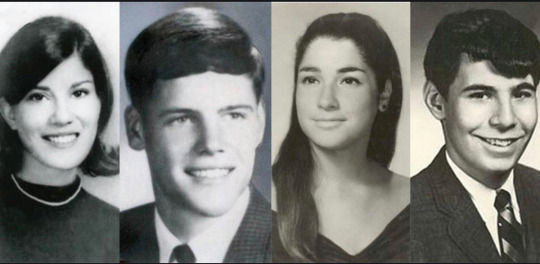
Ohio National Guardsmen in gas masks and with rifles as they prepare to advance up Blanket Hill, through clouds of teargas, to drive back Kent State University students during an antiwar demonstration on the university's campus, Kent, Ohio, May 4, 1970
The shooting lasted a total of 13 seconds. These students lost their lives:
Jeffrey Miller - 20
Allison Krause - 19
William Knox Schroeder - 19
Sandra Lee Scheuer - 20
(and nine injured)
Kent State University’s virtual 50th Commemoration to honor and remember the events of May 4, 1970
READ MORE https://www.kent.edu/may4kentstate50
youtube
Celebrating Another 50th Anniversary: The Student Strike of 1970 May 1, 2020
READ MORE https://woodstockfolkfestival.org/2020/05/01/celebrating-another-50th-anniversary-the-student-strike-of-1970/#comment-13
radio soundtrack
“Ohio” by Crosby, Stills, Nash & Young – written by Neil Young in reaction to the Kent State shootings
“Kent” by Magpie (the duo of Terry Leonino and Greg Artzner) on their album Give Light; Terry Leonino is a survivor of the Kent State shootings
Dave Brubeck’s cantata “Truth is Fallen” was dedicated to the slain students of Kent State and Jackson State and other innocent victims
Marvin Gaye’s “What’s Going On?”
Steve Miller’s “Jackson-Kent Blues”
Bruce Springsteen’s “Where Was Jesus in Ohio?”
Barbara Dane’s “The Kent State Massacre”
“I-Feel-Like-I’m-Fixin-to-Die” by Country Joe and the Fish
“For What It’s Worth” by Buffalo Springfield
“Fortunate Son” by Creedence Clearwater Revival
“Ain’t Gonna Let Nobody Turn Me Around” by Joan Baez
“The Universal Soldier” by Buffy Sainte-Marie (also a hit for Donovan)
“Bring ‘Em Home” by Pete Seeger
“Give Peace a Chance” by John Lennon
“Masters of War” and “Blowin’ in the Wind” by Bob Dylan
“War” by Edwin Starr
Books and Resources
Which Side Are You On? 20th Century American History in 100 Protest Songs by James Sullivan
33 Revolutions per Minute: A History of Protest Songs by Dorian Lynskey
Songs of America: Patriotism, Protest, and the Music That Made a Nation by Jon Meacham and Tim McGraw
Music and Social Movements: Mobilizing Traditions in the Twentieth Century by Ron Eyerman and Andrew Jamison
Talkinʼ Bout a Revolution: Music and Social Change in America by Dick Weissman
Playing for Change: Music and Musicians in the Service of Social Movements by Rob Rosenthal and Richard Flacks
The Routledge History of Social Protest in Popular Music by Jonathan Friedman
The Republic of Rock: Music and Citizenship in the Sixties Counterculture by Michael J. Kramer
Politics in Music: Music and Political Transformation from Beethoven to Hip-Hop by Courtney Brown
Troubadours & Troublemakers: The Evolution of American Protest Music by Kevin Comtois
Exploring American Folk Music: Ethnic, Grassroots, and Regional Traditions in the United States by Kip Lornell
Music in the Air: The Selected Writings of Ralph J. Gleason edited by Toby Gleason (Ralph was co-founder of Rolling Stone magazine)
Music: A Subversive History by Ted Gioia
American Radicals: How Nineteenth-Century Protest Shaped the Nation by Holly Jackson
Music is Power: Popular Songs, Social Justice, and the Will to Change by Brad Schreiber
Sounds of Freedom: Musicians on Spirituality and Social Change by John Malkin
Curriculum materials produced by Facing History and Ourselves – “How Can Music Inspire Social Change?”
The Social Power of Music – Smithsonian Folkways Recordings (4-disc box set and book)
Womenʼs Suffrage
Music in the Womenʼs Suffrage Movement – collection at Library of Congress – includes a digital collection of Womenʼs Suffrage in Sheet Music
Songs of the Suffragettes – Smithsonian Folkways Recordings
“Let Us Sing As We Go: The Role of Music in the United States Suffrage Movement” by R.L. Brandes (appears to be a dissertation at the University of Maryland – may be accessible online)
The Womenʼs Suffrage Movement edited by Sally Roesch Wagner
Why They Marched: Untold Stories of the Women Who Fought for the Right to Vote by Susan Ware
National Womenʼs History Museum (www.womenshistory.org) has materials and article by Nancy Hayward on their website has a list for further reading
The Music of the Suffrage Movement by Kate McKenzie at www.awsom.info Reviews of ʼ19: The Musical – musical last November in Washington, D.C. that was called “the Hamilton of Womenʼs History” – at National Archives
The Music of Womenʼs Suffrage – Amaranth Publishing – sheet music (this led me down an interesting path of other articles such as Women Ragtime Composers)
Earth Day and the Environment
Silent Spring by Rachel Carson
Earthrise Global Mobilizations – earthrise2020.org (please note this is entirely separate from the Festival’s “Earthrise” concert in 2018)
Walden by Henry David Thoreau
American Earth: Environmental Writing Since Thoreau by Bill McKibben
Never Cry Wolf by Farley Mowat
Writings by John Muir
Gorillas in the Mist by Dian Fossey
The Uninhabitable Earth: Life After Warming by David Wallace-Wells
The Death and Life of the Great Lakes by Dan Egan
An Inconvenient Truth: The Crisis of Global Warming and An Inconvenient Sequel: Truth to Power, both by Al Gore
It’s Getting Hot in Here: The Past, Present, and Future of Climate Change by Bridget Heos
Unstoppable: Harnessing Science to Change the World by Bill Nye
World Without Fish: How Could We Let This Happen? by Mark Kurlansky
Weather Makers by Tim Flannery
A Sand County Almanac: With Essays on Conservation by Aldo Leopold
Songs by Malvina Reynolds, Pete Seeger, Joni Mitchell, John Denver, Peter, Paul & Mary, and Neil Young; music by the Paul Winter Consort and John Cage; Live Earth Concert from 2007
Student Strike of 1970 and the Antiwar Movement
Vietnam and the American Political Tradition: The Politics of Dissent by Randall B. Woods
Sitting in and Speaking Out: Student Movements in the American South, 1960-1970 by Jeffrey A. Turner
Give Peace a Chance: Exploring the Vietnam Antiwar Movement by Melvin Small; William D. Hoover
The Vietnam War on Campus: Other Voices, More Distant Drums by Marc Jason Gilbert
The Movement and the Sixties by Terry H. Anderson
The 1960s Cultural Revolution by John C. McWilliams
From Yale to Jail by Dave Dellinger
The War Within: America’s Battle over Vietnam by Tom Wells
The Things They Carried by Tim O’Brien
An American Ordeal: The Antiwar Movement of the Vietnam Era by Charles Chatfield
Catch-22 by Joseph Heller
The Quiet American by Graham Greene
The Best and the Brightest by David Halberstam
Born on the Fourth of July by Ron Kovic
Fire in the Lake: The Vietnamese and the Americans in Vietnam by Frances FitzGerald
Vietnam: A History by Stanley Karnow
Public television’s Vietnam: A Television History and Ken Burns’ Vietnam War series
Songs by Phil Ochs, Buffy Sainte-Marie, Joan Baez, Pete Seeger, Peter, Paul & Mary, Bob Dylan, Country Joe & the Fish, Barry McGuire, Tom Paxton, Arlo Guthrie, John Lennon, Edwin Starr, Barbara Dane, and Crosby, Stills, Nash & Young, among many others.
https://woodstockfolkfestival.org/aiovg_videos/woodstock-folk-festival-9th-annual-invitational-concert/
youtube
Ohio" cover The Steppin Stones doing a great Neil Young cover at their July 4th, 2013 show in City Market in Savannah, GA.
2 notes
·
View notes
Text
A year in review
I was tagged by @billytheskywalker for this. Thank you so much, for keeping me entertained with these tag games, Darling. 😋
Top 5 movies I saw in 2019
6 Underground (very shocking, I know... I'm full of surprises)
How to Train Your Dragon 3
Rocketman
Yesterday
Johnny English Strikes Again
Top 5 shows I watched in 2019
The Handmaid's Tale
Chicago Fire
The Simpsons
Two and a Half Men
Magnificent Century
Top 5 books I read in 2019
The Red Scrolls of Magic by Cassandra Clare
Queen of Air and Darkness by Cassandra Clare
Gorillas in the Mist by Dian Fossey (There are some books I already read countless times, yet I couldn't get bored of them, this is one of them. Miss Fossey is one of my role models, I really look up to her)
Abigél by Magda Szabó (all-time favourite)
Doctor in the Zoo: The Making of a Zoo Vet by David Taylor (hilarious stories, this is a must-read, believe me. I read it several times, but it's still fascinating)
Top 5 songs of 2019 I listened the most
In the Lap of the Gods by Queen
Kill My Mind by Louis Tomlinson
I'm Still Standing by Elton John
99 by Toto
Only You by Toto
Top 5 cool things that happened to me in 2019
I was in a two week long Summer Camp in Beijing - and survived miraculously - I almost didn't 🤣
I travelled for the first time on a Plane, and the thing which was one of my biggest fears become something I got to love
I got a chance to study abroad next semester
I wrote a sort of scientific paper and I won a competition with it
I made some new friends, which is a big thing for me because I'm a total introvert person
If you are interested in this game and want to be tagged, write to me and I will tag you 😉
6 notes
·
View notes
Photo
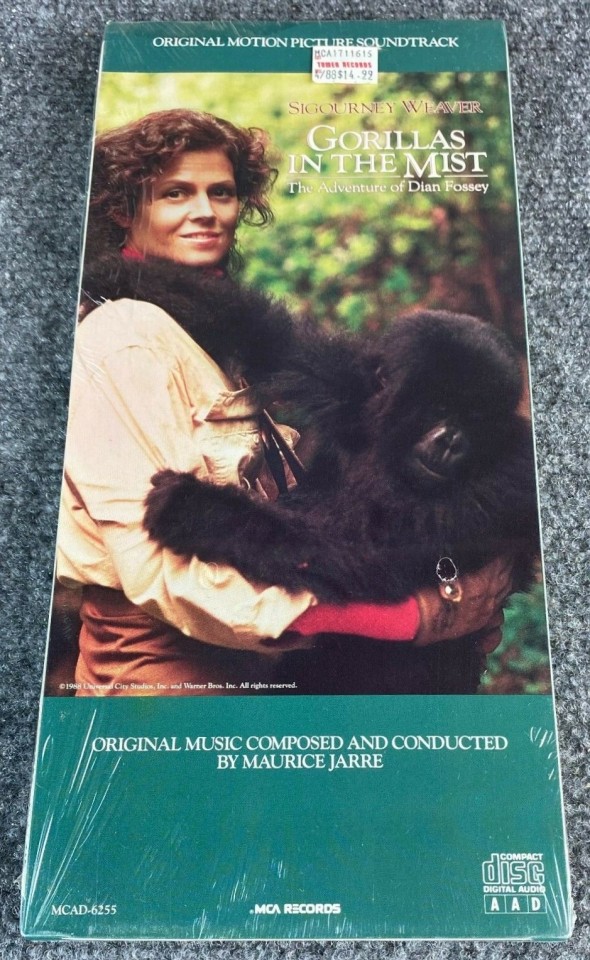
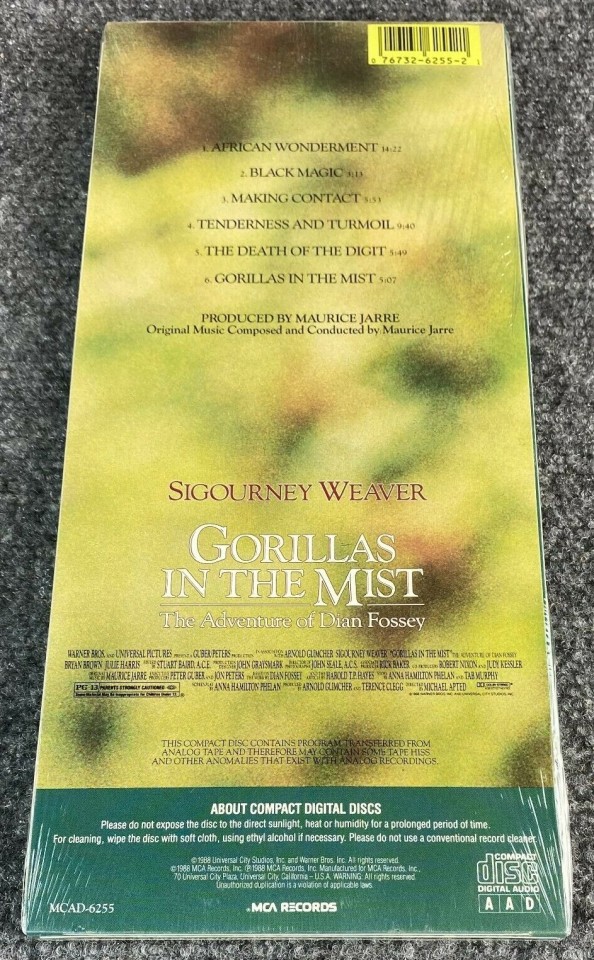
#Gorillas in the Mist The Story of Dian Fossey#Gorillas in the Mist#Dian Fossey#Maurice Jarre#Sigourney Weaver#Michael Apted#Harold T.P. Hayes#Anna Hamilton Phelan#Tab Murphy#Soundtrack#CD#80s
18 notes
·
View notes
Link
There are more gorillas in the mist — a rare conservation success story, scientists say.
After facing near-extinction, mountain gorillas are slowly rebounding. On Wednesday, the Switzerland-based International Union for Conservation of Nature updated mountain gorillas' status from "critically endangered" to "endangered," a more promising, if still precarious, designation. There are now just over 1,000 of the animals in the wild.
"In the context of crashing populations of wildlife around the world, this is a remarkable conservation success," said Tara Stoinski, president and chief scientist of the Dian Fossey Gorilla Fund.
Continue Reading.
345 notes
·
View notes
Photo

This baby sperm whale was tangled in ocean trash for 3 years
Craig Welch - January 2, 2019
A thick strand of rope, a wayward piece of quarter-inch cord from a fishing net, dangled off the tail of a young sperm whale. To the untrained eye, the line looked harmless—a lasso cinched near the base of the animal's fluke. But Gero knew the rope was a killer.
The photographs emailed from a colleague showed the heavy rope weighing down the animal's tail. That could prevent her from diving, which is how sperm whales hunt food. As she grew, the constriction would also slice through her flesh, strangling tissue like a garrote. The line might even amputate her fluke, though infection or starvation would probably do her in first.
At home in Ottawa, Gero pushed back from the computer. He called his wife and tried not to cry.
Digit the sperm whale was not quite four, but Gero had known her family for years. Each spring for a decade the Canadian behavioral ecologist had abandoned his own brood to spend months with these whales in the Caribbean Sea near the tiny West Indies island nation of Dominica. Though not yet 40, the assistant professor at Aarhus University in Denmark was rapidly becoming the world's foremost expert on baby sperm whales. Digit and her relatives were his star subjects.
Digit's very existence was significant. Thousands of sperm whales traverse the world's oceans. But 12 of the 16 whale families that returned each year to this stretch of the Caribbean were dying off. Each family could be down to a single whale in just 15 years.
Also, sperm whale families are matrilineal. Adult males eventually get cast out, and females bear the exclusive burden of rearing the young. For years, the family had produced a string of males. Three of them—Thumb, Tweak, and Enigma—had died already. Scar would soon disappear.
The family needed a female calf.
So Digit's arrival in 2011 left Gero's research team ecstatic. The crew watched Digit wean herself from her mother, Fingers. They cheered when she flipped her fluke up for her first deep dive. With Digit's arrival, the most-studied sperm whale family in the world seemed poised to carry on.
Then, in 2015, Gero received the images.
Sociable leviathans
In literature, sperm whales are ship-splintering beasts—monsters of "inscrutable malice," as Ahab seethed in Herman Melville's Moby Dick. In reality, that is far from true.
The world's largest toothed whales have the animal kingdom's biggest brains. The deep-diving nomads share membership in clans that can number in the thousands. Each clan chatters in its own dialect using a unique set of click patterns. These whales are social and playful. They roll and rub against each other near the surface. Some engage in hide-and-seek games, swimming circles around scientists' research boats and rolling sideways to eye the inhabitants. Sperm whales also are quite curious, especially when spying unfamiliar debris.
Gero, a National Geographic Explorer, could guess what had happened to Digit. Caribbean fishermen anchor nets to the sea floor to lure marlin, tuna, and mahi mahi. Whales rarely disturb that fixed gear, but container and cruise ships often accidentally shred it. Flapping ghost nets draw inquisitive creatures, and those loose lines are to whales what spider webs are to flies. While there are no reliable global statistics, at least 76 large whales, including humpbacks, blues, and minkes, got trapped in nets, lines, or debris in 2017—just in United States waters. And the vast majority of entanglements go unseen.
Gero suspects Digit simply snagged a loop of loose line. Three other whales in the region had recently been snared by fishing gear. One, a mother with a broken jaw, was forced to drag her dead calf for days after both got trapped in the same nest of lines. (The mother's injured mouth suggested she'd tried gnawing the calf free.)
Gero and colleagues reached out to Michael Moore, senior scientist at Woods Hole Oceanographic Institution in Massachusetts. He had helped untangle endangered North Atlantic right whales.
Moore's assessment was bleak. The pictures showed Digit's noose was tight. Only a dozen feet of line trailed her—too little to attach buoys to keep a deep-diving sperm whale near the surface. That was essential for rescuers to work. Without more line, a team would struggle to get close.
"There was so little gear on her," Moore says. "It was not going to be a slam dunk."
There were other complications. Dominica isn't New England. There wasn't a trained disentanglement crew for hundreds of miles. Getting one would take money and time. No one knew how much time they had.
"We were confronted with the long-term, chronic, slow death of an animal we see every day—one we thought we'd know forever," Gero says.
It felt personal.
Getting to know them
Gero had studied under sperm whale guru Hal Whitehead, at Halifax's Dalhousie University. Whitehead believed these sophisticated leviathans deserved the same respect as primates. Whitehead mostly studied adults. As a student, Gero wanted to learn about the young: Which family members raised them? When did they first dive deep? How did they learn their dialect—and from whom?
So in 2005, the young scientist arrived in Dominica aboard Whitehead's 40-foot research sailboat, Balaena. There he found a gathering of whales he would dub the Group of Seven, named for a collective of famed Canadian painters.
The Group of Seven tended to spend weeks near this coast. They were spotted more often than other whales. That first year, Gero's team spent an astonishing 40 days cataloging this one family's behavior.
"We'd go into shore and get groceries and come back and we'd still see the same animals just offshore," Gero says. "That's unheard of."
It's why their names seem flip—Gero needed to tell them apart, but had never expected he'd see them again.
As with Jane Goodall's chimpanzees and Dian Fossey's mountain gorillas, intimate access revealed each animal's distinct habits and personality. Over time, Gero began to see these whales as individuals.
Fingers appeared to be in charge. She usually broadcast the "coda," four clicks that identified the family to other whales, like a surname. When her offspring, Thumb, died, Fingers helped watch over others' young. She steered clear of people and was known for spectacular dives, muscling her fluke high before plunging straight down.
"It's hard to describe how beautifully she flukes to someone who doesn’t watch hundreds of whales do it," says Gero, whose research is conducted through Aarhus University's Marine Bioacoustics Laboratory. "It feels like she is demonstrating to others the way."
Fingers' niece, Pinchy, was mother to Scar, who was so comfortable with humans he'd become a star in Dominica's swim-with-whales tourism industry. There was sickly Quasimodo, and Mysterio, so named because she appeared rarely.
Gero felt a growing kinship with the cetaceans. "The whales were becoming a part of my life," he says. "My kids knew these animals by name even though they'd never met them."
The whales prompted him to rethink his views on conservation. In many sperm whale families, calves get milk from other calves' mothers. The Group of Seven's young only got milk from their actual mothers. If behaviors and communication were unique to clans or families, didn't that suggest conservation should be about more than total population numbers? Wasn't each clan special in its own right?
In 2011 a documentary crew arrived, led by a filmmaker who'd co-produced the Fossey biopic, Gorillas in the Mist. When Fingers gave birth to a new calf that week, Gero knew what to call her.
He named the new calf Digit, after Fossey's favorite silverback. Only later would he recall what humans did to Fossey's gorilla.
Wasting away
Before arriving in Dominica for the 2015 research season, Gero had only seen Digit's injuries in emailed pictures. In person things looked even worse. Before she got tangled, the young whale had just started swimming and diving alone. Now she only appeared with adults. She was reserved instead of curious. She kept her distance from boats and people.
"It was like she was trying to say, 'This is all your fault, you humans,'" says Pernell Francis, who has worked with Gero.
Gero could see the rope gouging her flesh. More troubling still: Digit couldn't raise her fluke. The rope was creating too much drag. As he'd feared, she could not dive deep, which was hampering her hunt for squid.
Word of Digit's condition spread. Ted Cheeseman, who took clients swimming with whales, raised money to hire a professional disentanglement team. Whale advocates whispered about cutting the rope themselves. Gero knew that was too dangerous.
"There are Internet videos where people have done it, but they're bloody lucky they didn't kill themselves," Moore says. A trained rescuer would die in 2017, after being struck by a whale he'd just freed.
Eventually someone took the plunge anyway. The diver shortened Digit's rope, but could not cut the noose. The shorter line reduced the drag on Digit's tail, but now even less cord remained for pros to work with.
Ultimately, no rescue crew would be coming. Cheeseman ended up using the money he'd raised to buy and stash equipment for future rescues. He paid to assemble and train a future Dominica disentanglement crew.
Digit, meanwhile, grew ever thinner. No longer able to catch her own food, she returned to being nursed by Fingers.
"It was like watching your child go back to crawling," Gero says.
People care
One afternoon in Dominica a boat zipped by and a woman shouted: "Hey Shane, how can I help Digit?" Gero was taken aback. Even strangers were worried.
That night Gero ate on the deck of his research boat, beneath a dangling headlamp. The Group of Seven was in trouble. That family was now on the brink, down to just three whales: Fingers, Pinchy, and Digit. But the stranger's query was a reminder that Digit's story held real power.
While humans are attached to dolphins and orcas, many can't even identify a sperm whale. Fewer still understand the gantlet of threats these nomads face: pollution, climate change, ship strikes, fishing gear.
"But people can understand a mom caring for a kid who is suddenly facing a chronic injury," Gero says.
Gero vowed something useful would come of Digit's wounds.
Over the next several years, Gero expanded his research's focus on conservation. He wrote and lectured more. He spoke at museums and even mentioned Digit's quandary during a TEDx Talk. He and a team mapped whale and vessel movements and urged the government to restrict ship traffic to areas that whales avoided. Gero hoped that might help fishing-boat operators find ship-free places to set nets.
"Digit changed the whole perspective of our project," Gero says. No longer was whale behavior his sole interest. Now he asked: "What can we do to ensure we all co-exist?"
Still he couldn't help Digit. She had not resumed fluking. Her flesh began to grow around the rope, closing over it. Gero suspected he was watching Digit die.
Miracle
Then last spring he saw her again from the bow of Balaena. Days into the 2018 field season, Digit popped to the surface. Gero knew immediately that everything had changed.
The outline of Digit's spine was no longer so visible. She had gotten plump. Looking closely, Gero could see abrasions and marks where the rope had rubbed. The line itself was simply gone.
A few months earlier, a colleague in Dominica had emailed to say he'd heard Digit had lost her rope. Gero had been hopeful, but skeptical. Now as Digit moved to slip below the surface, Gero's entire team fell silent. Digit flipped her fluke and dove. A cheer erupted from the boat. After three years, Digit was free.
Later, the scientist and his team would attach a tracking device to Digit's back. When they eventually reviewed the tag's data, Gero was overwhelmed. Digit was diving more than 3,000 feet. She was slurping up squid. Digit was behaving like a healthy seven-year-old whale.
No one knows how she got free. Cheeseman suspects that sunlight, time, and pressure weakened Digit's line until it finally broke. Moore says if Digit swam near a sharp rock or crevice, she might have scraped the deteriorating rope off. Other whales might even have helped.
"If someone told me two sperm whales had a tug of war over the line and it broke, I'd believe it," Moore says.
Gero has another idea. He saw fresh scars on Digit's fluke. He suspects predators may have attacked her and unwittingly ripped off the gear.
But Gero knows he'll never be certain. He almost prefers it that way.
"It's easy to forget that that there are thousands of species right next to us with rich and complicated worlds, living their lives in parallel with our own," Gero says.
A new generation of Eastern Caribbean sperm whale was swimming free. Knowing that would be enough.
25 notes
·
View notes
Text
10 days to go...
We had to laugh when Mike sent some more packing advice a week or so ago. He doesn’t know we’ve been comparing notes on what we’re packing since the spring, weighing electronics (the keyboard that makes this blog possible weighs 6 oz.), and loading the duffels to test weight and available space.
Africa, here we come!!! Light luggage, empty SD cards and a spirit of adventure.
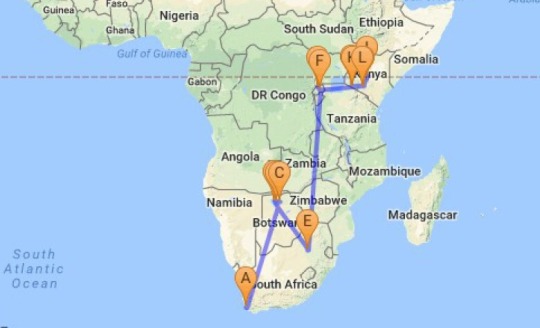
Our itinerary will take us to South Africa, Botswana, Rwanda and Kenya. How to get a preview of the history, customs, and natural wonders of our destinations? The movies!
South Africa
Invictus – A tribute to the inventive spirit of Nelson Mandela, the new president, who called on a rugby team to start healing the country following Apartheid.
In My Country — Enlightening story about horrendous Apartheid experiences, wrapped in a budding love story between an African American journalist and an Afrikaans writer covering the Truth and Reconciliation Commission hearings.
I Dreamed of Africa — Not a great movie, but earned a little respect on realizing that it is based on a true story. Plus, the title describes the last year for us.
Botswana
A United Kingdom – The true story of the Bechuanaland crown prince who brought his English wife home to turmoil and controversy. Their love persevered as they ushered in independence for their people as the Republic of Botswana.
The No. 1 Ladies Detective Agency – based on the endearing novels, by Alexander McCall Smith, about independent, industrious, and wise Precious Ramotswe, who opened a detective agency in her village to help her neighbors.
Rwanda
Gorillas in the Mist – The story of Dian Fossey and her study of the gorillas. She probably made it possible for our visit to these creatures.
Virunga — While it takes place in Congo, this documentary tells the story of human efforts to protect the mountain gorillas. Especially endearing was the ranger to tended to orphaned gorillas injured by poachers, particularly as unrest swelled around their refuge.
Kenya
Born Free – The ‘70s movie about a Elsa the lion and her human friends who worked to return her to the wild. And a nostalgic song.
Out of Africa – An epic about Karen Blixen’s time in early 20th century Kenya.
The Wildebeest Migration – A documentary about the powerful creatures and their continuing quest for grasslands, know for their massive migration. It shows the difficulty of their life on the move from birth to death, fending off cheetahs and crocodiles.
The Earth at Night: Africa -- The story of a baby elephant and his family who walk through several nights, fighting exhaustion, in search of water. Again, a realistic portrait of life on the move for wild creatures.
Imagine the Netflix recommendations after viewing these last two -- everything in their library about animals in the wild hunting and preying on each other.
Now it’s time for the real thing.
1 note
·
View note
Photo
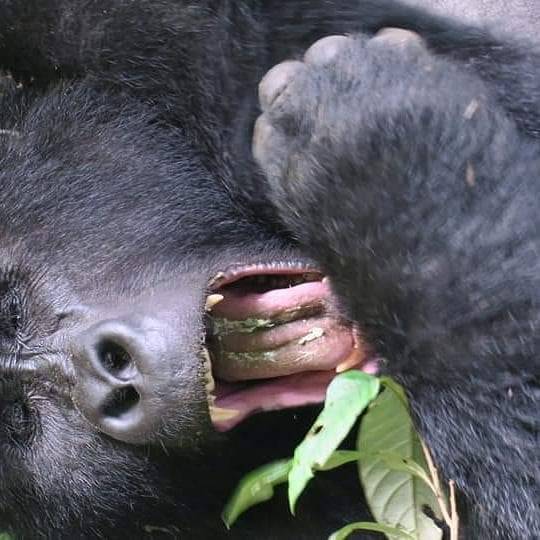
On the second floor of the Finnish Natural History Museum, a female gorilla gazes mournfully at the visitors filing past her. Until very recently, her story remained untold. As it turns out, she is one of Dian Fossey’s “gorillas in the mist”. Here is how her story begins: in 1969, the Rwandan government decided to sell two gorillas to the zoo in Cologne, then West Germany. Dian Fossey, the American primatologist and conservationist, who was working in Rwanda at the time, was vociferous in her opposition to this plan. The sale went ahead, despite Fossey’s objections. In the 1960s, international law still permitted the capture and sale of wild animals to zoos. The capture of the two infant female gorillas cost the lives of two entire mountain gorilla family groups. In order to give the baby gorillas a chance of survival, Fossey agreed to nurse them through their infancy. The babies thrived in her care, growing into healthy young gorillas. A bitterly sad separation followed, as the gorillas, now known as Coco and Pucker, were handed over to the German zoo for which they had originally been captured. ”Words cannot begin to express the pain I felt on losing them” At the zoo, despite the pair apparently receiving the best care available, they would live for just nine years before succumbing to bacterial infections within a few months of each other, in 1978. It is thought that their susceptibility to infection was due to a severely weakened immune system, and even the best efforts of the zoo’s veterinarians were not enough to save their lives. The congenital immune deficiency that Coco and Pucker, along with many others of their species, suffered from has been attributed to the high degree of inbreeding among gorilla populations. In the wild, where gorillas can live to 35–40 years of age, female gorillas do not start breeding until age seven or eight and often don’t produce their first offspring until around 10 years of age. @timeforafricatravel @thehorizonadventures @kipepeoexperienceworld https://www.instagram.com/p/B_mHDg7D6PI/?igshid=1a95w6iheliaf
0 notes